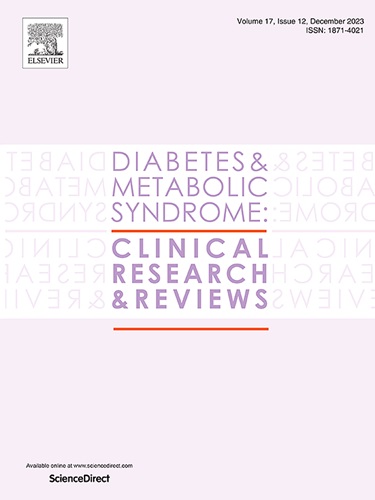日本糖尿病数据管理研究(JDDM76)中的机器学习算法模拟专家对2型糖尿病患者初始治疗的决策。
IF 3.4
Q1 ENDOCRINOLOGY & METABOLISM
Diabetes & Metabolic Syndrome-Clinical Research & Reviews
Pub Date : 2024-11-01
DOI:10.1016/j.dsx.2024.103168
引用次数: 0
摘要
目的:评估模拟专家护理的典型机器学习模型是否能够成功地复制信息,不仅是关于是否开具药物处方,还包括开具哪种降糖药作为2型糖尿病的初始治疗。研究设计和方法:利用包含16,005名首次就诊糖尿病医生的患者的药物处方的医疗记录数据库来训练五个典型的机器学习模型以及一个用于逻辑分析的模型。未开任何药物(饮食和运动疗法)、胰岛素、双胍类(BG)、磺脲类(SU)、二肽基肽酶-4抑制剂(DPP-4I)、α-葡萄糖苷酶抑制剂(α-GI)或格列尼特。根据F1评分和ROC/AUC评分对模型进行比较。结果:XGBoost将决策分为三个部分,在五个模型和传统逻辑回归(35%准确率)中表现最佳(42%准确率)。得分第二高的模型是支持向量机,准确率为40%。当使用XGBoost比较不需要药物治疗和需要药物治疗的决定时,AUC为0.96。胰岛素与口服药物的AUC为0.78。除去所有剩余的口服药物后,AUC为0.76。结论:在研究的五个模型中,XGBoost的表现优于其他机器学习模型以及传统的logistic模型,这表明它的准确性有可能在未来帮助非专业人士做出关于2型糖尿病患者治疗的决策。本文章由计算机程序翻译,如有差异,请以英文原文为准。
Machine learning algorithms mimicking specialists decision making on initial treatment for people with type 2 diabetes mellitus in Japan diabetes data management study (JDDM76)
Objective
To evaluate whether typical machine learning models that mimic specialists’ care can successfully reproduce information, not only on whether to prescribe medications but also which hypoglycemic agents to prescribe as initial treatment for type 2 diabetes.
Research design and methods
A medical records database containing prescriptions for medications for 16,005 patients who visited a diabetologist's office for the first time was utilized to train five typical machine learning models as well-as a model used for logistic analysis. Prescribed were no medications (diet and exercise therapy), insulin, biguanides (BG), sulfonylureas (SU), dipeptidyl peptidase-4 inhibitors (DPP-4I), alpha-glucosidase inhibitors (α-GI) or glinides. Models were compared based on the F1 score and ROC/AUC scores.
Results
XGBoost, which splits decision-making into three sections, was the top performing model (42 % accuracy) among five models and conventional logistic regression (35 % accuracy). The second highest scoring model was Support Vector Machines, which had an accuracy of 40 %. When using XGBoost to compare decisions on no medication needed vs. needing medication the AUC was 0.96. Insulin vs. oral medications had an AUC of 0.78. With all remaining oral medications removed, the AUC was 0.76.
Conclusions
Among the five models investigated, XGBoost outperformed the other machine learning models examined as well as the traditional logistic model, suggesting that its accuracy had the potential to assist non-specialists in decision-making regarding treatment of patients with type 2 diabetes in the future.
求助全文
通过发布文献求助,成功后即可免费获取论文全文。
去求助
来源期刊

Diabetes & Metabolic Syndrome-Clinical Research & Reviews
ENDOCRINOLOGY & METABOLISM-
CiteScore
22.90
自引率
2.00%
发文量
248
审稿时长
51 days
期刊介绍:
Diabetes and Metabolic Syndrome: Clinical Research and Reviews is the official journal of DiabetesIndia. It aims to provide a global platform for healthcare professionals, diabetes educators, and other stakeholders to submit their research on diabetes care.
Types of Publications:
Diabetes and Metabolic Syndrome: Clinical Research and Reviews publishes peer-reviewed original articles, reviews, short communications, case reports, letters to the Editor, and expert comments. Reviews and mini-reviews are particularly welcomed for areas within endocrinology undergoing rapid changes.
 求助内容:
求助内容: 应助结果提醒方式:
应助结果提醒方式:


